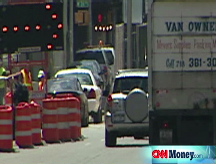Bonds boosted by auto bailout support
The rescue plan for the Big Three fails in a key Senate test, but as the White House and President-elect Obama express support for the auto industry, prices ease off earlier highs.
NEW YORK (CNNMoney.com) -- Treasury prices edged higher Friday, reversing course as the auto industry bailout that was rejected by the Senate late Thursday night garnered support from the White House and President-elect Barack Obama.
Late Thursday, the $14 billion rescue package for the U.S. auto industry failed to muster enough votes in the Senate to advance the legislation. The House passed it Wednesday night.
The stopgap bill was a temporary measure intended to keep General Motors (GM, Fortune 500) and Chrysler LLC out of bankruptcy. The potential demise of one of the Detroit Big Three puts significant numbers of jobs in jeopardy. and that is keeping investors on edge.
"The bond market is generally the quickest to recognize fear or fear subsiding," said Kenneth Naehu, managing director and head of fixed income at Bel Air Investment Advisors. "In this particular case you have what happened overnight in the Senate causing fear, and then quickly being reversed by comments from the White House and President-elect Obama saying he is disappointed by the Senate."
The U.S. automakers could still end up with government funding. The White House said that it will consider using money from the $700 billion bailout to "prevent a collapse of troubled automakers," according to a written statement released Friday morning.
And Obama chimed in, saying he hoped the government "will still find a way to give the industry the temporary assistance it needs while demanding the long-term restructuring that is absolutely required."
When the White House statement came out, "that reversed the bonds," said Naehu, because it suggested the automakers will not be left to twist in the wind, boosting investor confidence.
"People want to be long fixed income over the weekend," said Andrew Brenner, senior vice president at MF Global. "When you don't know, when there is uncertainty, people will buy fixed income," said Brenner. "People will buy high- grade fixed income," like debt from Uncle Sam, he added.
Prices came off earlier highs though, as investors signaled an unwillingness to make strong bets.
In recent weeks, demand for the safety of Treasurys has pushed prices to record highs and yields to record lows. On some of the shorter-term bills, yields have actually dipped negative - meaning that investors pay the government to hold their assets.
Debt prices: The benchmark 10-year Treasury was up 9/32 to 110-8/32 and its yield dipped to 2.57% from 2.62% from late Thursday. Bond prices and yields move in opposite directions.
Two weeks ago, the 10-year yield fell below 3% for the first time since the note was first issued in 1962, and on Dec. 4, the yield on the benchmark Treasury ended at a record low of 2.55%.
The 30-year recovered earlier losses to be up 12/32 to 128-4/32 and its yield dipped to 3.05% from 3.08%. The record-low yield for the 30-year was 3.06%, where it closed on Dec. 4 and Dec. 9.
The 2-year note rose 10/32 to 100-30/32 and its yield dipped to 0.77% from 0.80%. The 2-year note has been at record-low yields. On Dec. 4, the yield on the 2-year note closed at a record low of 0.82% but then Thursday, the yield fell even further to close for the day at 0.80%.
The yield on the 3-month note was 0.025%, and has been hovering around 0% for days. Yields near the zero mark on short-term bills are an indication that investors are completely risk averse, putting safety at a priority above profit.
Lending rates: Meanwhile, lending rates between banks continued to fall, in a positive sign for the credit markets.
The overnight Libor rate held at its record low of 0.12% Friday, according to Bloomberg.com. The bank-to-bank lending rate has been at record lows as central banks around the world have pushed their key lending rates down.
Libor, the London Interbank Offered Rate, is a daily average of what 16 different banks charge other banks to lend money in London, and is used to calculate adjustable-rate mortgages. More than $350 trillion in assets are tied to Libor.
The 3-month Libor rate fell to 1.92% from 2.0% late Thursday.
Two market gauges showed confidence edging higher.
The "TED spread" narrowed to 1.89 percentage points from 1.98 percentage points Thursday. The TED spread measures the difference between the 3-month Libor and the 3-month Treasury bill, and is a key indicator of risk. The higher the spread, the more unwilling investors are to take risks.
Another indicator, the Libor-OIS spread, narrowed to 1.62 percentage points from 1.72 percentage points. The Libor-OIS spread measures how much cash is available for lending between banks, and is used for determining lending rates. The bigger the spread, the less cash is available for lending. ![]()






